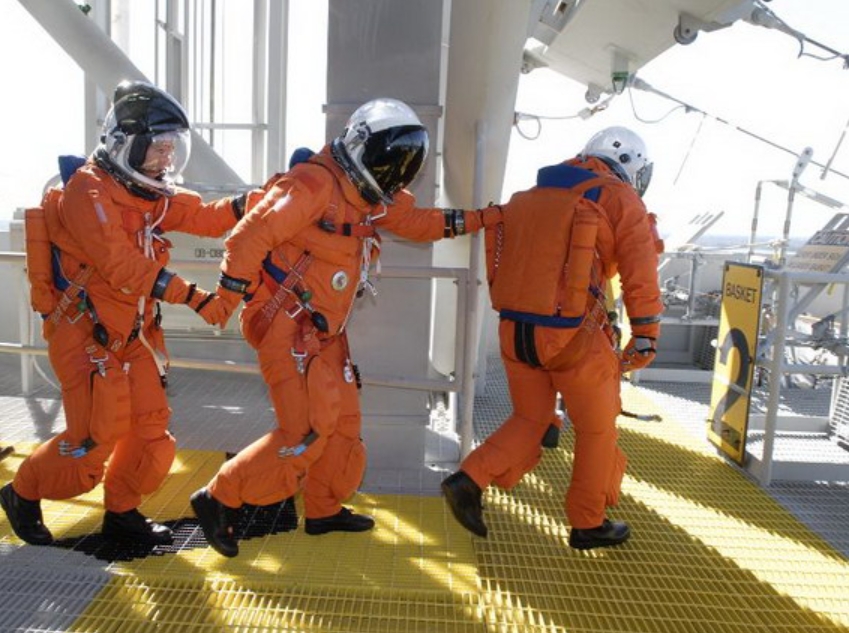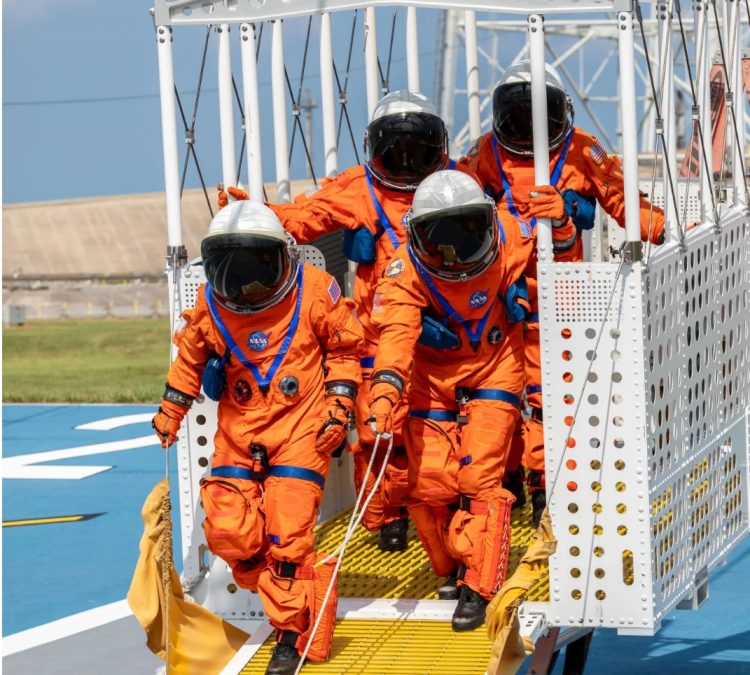Introduction
Safety is paramount in the realm of space exploration. The complexities and inherent risks associated with space missions require rigorous safety protocols and contingency plans. On August 14, 2024, NASA conducted a vital practice exercise focused on escape procedures, demonstrating its commitment to astronaut safety and mission success. This article explores the significance of these exercises, the details of the practice escape, and the broader implications for space mission safety and readiness.
The Importance of Escape Procedures
1. Ensuring Astronaut Safety
Escape procedures are critical for ensuring the safety of astronauts in the event of an emergency during launch, ascent, or while in space. These procedures are designed to provide a reliable means of quickly and safely evacuating astronauts from the spacecraft or space station if necessary.
A. Emergency Scenarios
- Launch Emergencies: During the launch phase, various emergencies can arise, including rocket malfunctions, structural failures, or other unforeseen issues. Escape procedures ensure that astronauts can be rapidly evacuated from the spacecraft if a critical situation occurs.
- In-Space Emergencies: In space, emergencies such as life support system failures, fire, or other critical incidents require well-defined escape plans to ensure astronauts can safely return to Earth or move to a safe location.
B. Training and Preparedness
- Simulation Training: Astronauts undergo extensive training to prepare for escape procedures. This includes simulation exercises that replicate potential emergency scenarios, allowing astronauts to practice their response and ensure they are familiar with the procedures.
- Safety Drills: Regular safety drills and exercises are conducted to keep astronauts and mission control personnel prepared for various emergency situations. These drills help identify potential issues and improve response strategies.
Details of the Practice Escape Exercise
1. Objectives and Goals
The recent practice escape exercise conducted by NASA aimed to test and refine the procedures for safely evacuating astronauts in the event of an emergency. This exercise was a crucial component of NASA’s ongoing efforts to enhance safety protocols and ensure mission readiness.
A. Exercise Scenarios
- Launch Abort Test: The exercise simulated a launch abort scenario, where an emergency situation during the launch phase required an immediate escape. This involved testing the spacecraft’s abort systems and evaluating the effectiveness of the escape procedures.
- In-Space Emergency Drill: The drill also included scenarios where astronauts faced emergencies while in space. This tested the procedures for returning to Earth or moving to a safe location if an in-space emergency occurred.
B. Participants and Roles
- Astronauts: The exercise involved astronauts who participated in the simulation to practice their roles and responses during an emergency. Their participation was crucial for evaluating the effectiveness of the escape procedures.
- Mission Control: Mission control personnel played a key role in coordinating the exercise, monitoring the simulation, and providing support and guidance to the astronauts. Their involvement ensured that the exercise was conducted smoothly and effectively.

2. Execution and Procedures
A. Simulation Setup
- Spacecraft Configuration: The practice escape exercise utilized a spacecraft configured to replicate real mission conditions. This included the installation of escape systems and safety equipment to simulate an authentic environment.
- Emergency Scenarios: The exercise included various emergency scenarios, such as system malfunctions, fire, and structural issues. These scenarios were designed to test the astronauts’ ability to respond effectively and execute the escape procedures.
B. Performance Evaluation
- Response Times: The exercise measured the response times of astronauts and mission control personnel, assessing how quickly they could react to and manage emergency situations. This data is critical for improving procedures and ensuring timely responses.
- Procedure Effectiveness: The effectiveness of the escape procedures was evaluated based on the exercise outcomes. This included assessing the reliability of the escape systems, the clarity of the procedures, and the overall efficiency of the response.
3. Lessons Learned and Improvements
A. Identifying Areas for Improvement
- Procedure Refinement: The exercise highlighted areas for improvement in the escape procedures, such as the need for clearer instructions or additional training for astronauts. These insights are used to refine and enhance the procedures.
- System Upgrades: Feedback from the exercise may lead to upgrades or modifications to the escape systems, ensuring they are more effective and reliable in real emergency situations.
B. Continuous Improvement
- Ongoing Training: Regular practice escape exercises and training sessions are essential for maintaining readiness and improving procedures. Continuous evaluation and refinement help ensure that astronauts and mission control personnel are always prepared for emergencies.
- Collaborative Efforts: Collaboration between NASA, industry partners, and other space agencies contributes to the ongoing development and improvement of safety protocols and escape procedures. Sharing knowledge and best practices enhances overall mission safety.
Broader Implications for Space Missions
1. Enhancing Mission Safety
A. Reducing Risks
Effective escape procedures are vital for reducing risks and ensuring the safety of astronauts. By preparing for various emergency scenarios, NASA can minimize potential hazards and enhance the overall safety of space missions.
B. Building Confidence
The practice escape exercise helps build confidence among astronauts and mission control personnel, ensuring they are prepared to handle emergencies effectively. This confidence is crucial for the success of space missions and the well-being of the crew.
2. Supporting Future Missions
A. Mission Readiness
The insights gained from practice escape exercises contribute to mission readiness by identifying potential issues and ensuring that procedures are effective and reliable. This preparation is essential for the success of future space missions.
B. Advancing Technology
Ongoing exercises and evaluations drive advancements in technology and safety systems. Innovations in escape systems, life support technologies, and emergency protocols contribute to the overall success of space exploration efforts.
3. Inspiring Public Confidence
A. Public Awareness
NASA’s commitment to safety and preparedness is important for public confidence in space exploration. By demonstrating rigorous training and preparedness measures, NASA ensures that the public understands the efforts taken to ensure astronaut safety.
B. Encouraging STEM Engagement
The focus on safety and preparedness can inspire future generations to pursue careers in science, technology, engineering, and mathematics (STEM). Understanding the complexities of space missions and safety procedures highlights the importance of these fields in advancing space exploration.
Challenges and Opportunities
1. Technical Challenges
A. System Reliability
Ensuring the reliability of escape systems and procedures presents technical challenges, including the need for rigorous testing and validation. Addressing these challenges is essential for maintaining the effectiveness of escape protocols.
B. Emergency Scenarios
Simulating and preparing for a wide range of emergency scenarios requires careful planning and execution. The complexity of these scenarios demands advanced technologies and thorough training to ensure readiness.
2. Opportunities for Innovation
A. Technological Advancements
The practice escape exercise presents opportunities for technological advancements in escape systems and safety protocols. Innovations in these areas contribute to improving mission safety and effectiveness.
B. Collaborative Research
Collaborating with industry partners, other space agencies, and research institutions provides opportunities for sharing knowledge and developing new solutions. These collaborative efforts enhance overall safety and mission success.
Conclusion
The practice escape exercise conducted by NASA on August 14, 2024, represents a critical component of the agency’s commitment to astronaut safety and mission readiness. By simulating emergency scenarios and testing escape procedures, NASA ensures that astronauts and mission control personnel are prepared to handle emergencies effectively.
The insights gained from these exercises contribute to refining procedures, upgrading systems, and advancing technology, ultimately enhancing the safety and success of space missions. Through rigorous training, continuous improvement, and collaborative efforts, NASA remains at the forefront of space exploration and safety.
The focus on escape procedures and safety highlights NASA’s dedication to ensuring the well-being of astronauts and the success of space missions. By preparing for emergencies and addressing potential risks, NASA builds confidence in its capabilities and inspires future generations to pursue careers in STEM fields.
As space exploration continues to advance, the lessons learned from practice escape exercises will play a crucial role in shaping the future of space missions. NASA’s commitment to safety and preparedness underscores its dedication to exploring the cosmos while ensuring the highest standards of astronaut safety and mission success.


















































Discussion about this post